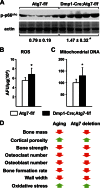Suppression of autophagy in osteocytes mimics skeletal aging
- PMID: 23645674
- PMCID: PMC3682543
- DOI: 10.1074/jbc.M112.444190
Suppression of autophagy in osteocytes mimics skeletal aging
Abstract
Bone mass declines with age but the mechanisms responsible remain unclear. Here we demonstrate that deletion of a conditional allele for Atg7, a gene essential for autophagy, from osteocytes caused low bone mass in 6-month-old male and female mice. Cancellous bone volume and cortical thickness were decreased, and cortical porosity increased, in conditional knock-out mice compared with control littermates. These changes were associated with low osteoclast number, osteoblast number, bone formation rate, and wall width in the cancellous bone of conditional knock-out mice. In addition, oxidative stress was higher in the bones of conditional knock-out mice as measured by reactive oxygen species levels in the bone marrow and by p66(shc) phosphorylation in L6 vertebra. Each of these changes has been previously demonstrated in the bones of old versus young adult mice. Thus, these results demonstrate that suppression of autophagy in osteocytes mimics, in many aspects, the impact of aging on the skeleton and suggest that a decline in autophagy with age may contribute to the low bone mass associated with aging.
Keywords: Aging; Autophagy; Bone; Mouse; Osteocyte; Remodeling.
Figures






Similar articles
-
Suppression of autophagy in osteocytes does not modify the adverse effects of glucocorticoids on cortical bone.Bone. 2015 Jun;75:18-26. doi: 10.1016/j.bone.2015.02.005. Epub 2015 Feb 17. Bone. 2015. PMID: 25700544 Free PMC article.
-
Low bone mass and changes in the osteocyte network in mice lacking autophagy in the osteoblast lineage.Sci Rep. 2016 Apr 11;6:24262. doi: 10.1038/srep24262. Sci Rep. 2016. PMID: 27064143 Free PMC article.
-
Mitochondrial oxidative stress or decreased autophagy in osteoblast lineage cells is not sufficient to mimic the deleterious effects of aging on bone mechanoresponsiveness.Aging (Albany NY). 2025 Mar 18;17(3):610-629. doi: 10.18632/aging.206213. Epub 2025 Mar 18. Aging (Albany NY). 2025. PMID: 40105873 Free PMC article.
-
Basic biology of skeletal aging: role of stress response pathways.J Gerontol A Biol Sci Med Sci. 2013 Oct;68(10):1197-208. doi: 10.1093/gerona/glt079. Epub 2013 Jul 3. J Gerontol A Biol Sci Med Sci. 2013. PMID: 23825036 Free PMC article. Review.
-
What old means to bone.Trends Endocrinol Metab. 2010 Jun;21(6):369-74. doi: 10.1016/j.tem.2010.01.010. Epub 2010 Mar 11. Trends Endocrinol Metab. 2010. PMID: 20223679 Free PMC article. Review.
Cited by
-
Regulatory mechanisms of autophagy-related ncRNAs in bone metabolic diseases.Front Pharmacol. 2023 Dec 7;14:1178310. doi: 10.3389/fphar.2023.1178310. eCollection 2023. Front Pharmacol. 2023. PMID: 38146458 Free PMC article. Review.
-
Skeletal Aging.Mayo Clin Proc. 2022 Jun;97(6):1194-1208. doi: 10.1016/j.mayocp.2022.03.011. Mayo Clin Proc. 2022. PMID: 35662432 Free PMC article. Review.
-
Cold exposure-induced plasma exosomes impair bone mass by inhibiting autophagy.J Nanobiotechnology. 2024 Jun 23;22(1):361. doi: 10.1186/s12951-024-02640-z. J Nanobiotechnology. 2024. PMID: 38910236 Free PMC article.
-
Autophagy in major human diseases.EMBO J. 2021 Oct 1;40(19):e108863. doi: 10.15252/embj.2021108863. Epub 2021 Aug 30. EMBO J. 2021. PMID: 34459017 Free PMC article. Review.
-
Consequences of Aging on Bone.Aging Dis. 2023 Nov 20;15(6):2417-2452. doi: 10.14336/AD.2023.1115. Aging Dis. 2023. PMID: 38029404 Free PMC article.
References
-
- Manolagas S. C. (2000) Birth and death of bone cells: Basic regulatory mechanisms and implications for the pathogenesis and treatment of osteoporosis. Endocr. Rev. 21, 115–137 - PubMed
-
- Riggs B. L., Melton L. J., Robb R. A., Camp J. J., Atkinson E. J., McDaniel L., Amin S., Rouleau P. A., Khosla S. (2008) A population-based assessment of rates of bone loss at multiple skeletal sites: evidence for substantial trabecular bone loss in young adult women and men. J. Bone Miner. Res. 23, 205–214 - PMC - PubMed
-
- Almeida M., Han L., Martin-Millan M., Plotkin L. I., Stewart S. A., Roberson P. K., Kousteni S., O'Brien C. A., Bellido T., Parfitt A. M., Weinstein R. S., Jilka R. L., Manolagas S. C. (2007) Skeletal involution by age-associated oxidative stress and its acceleration by loss of sex steroids. J. Biol. Chem. 282, 27285–27297 - PMC - PubMed
Publication types
MeSH terms
Substances
Grants and funding
LinkOut - more resources
Full Text Sources
Other Literature Sources
Miscellaneous

